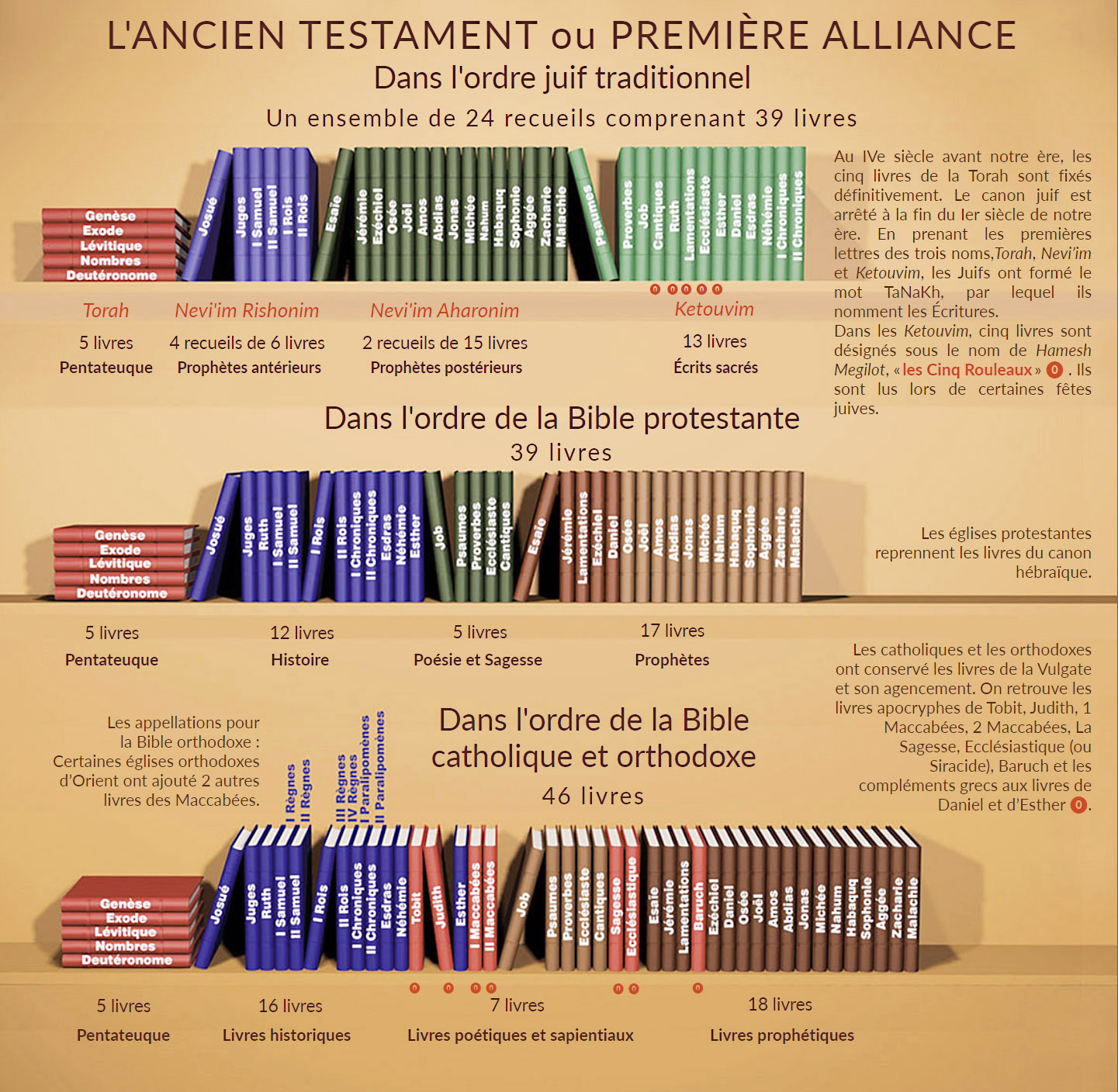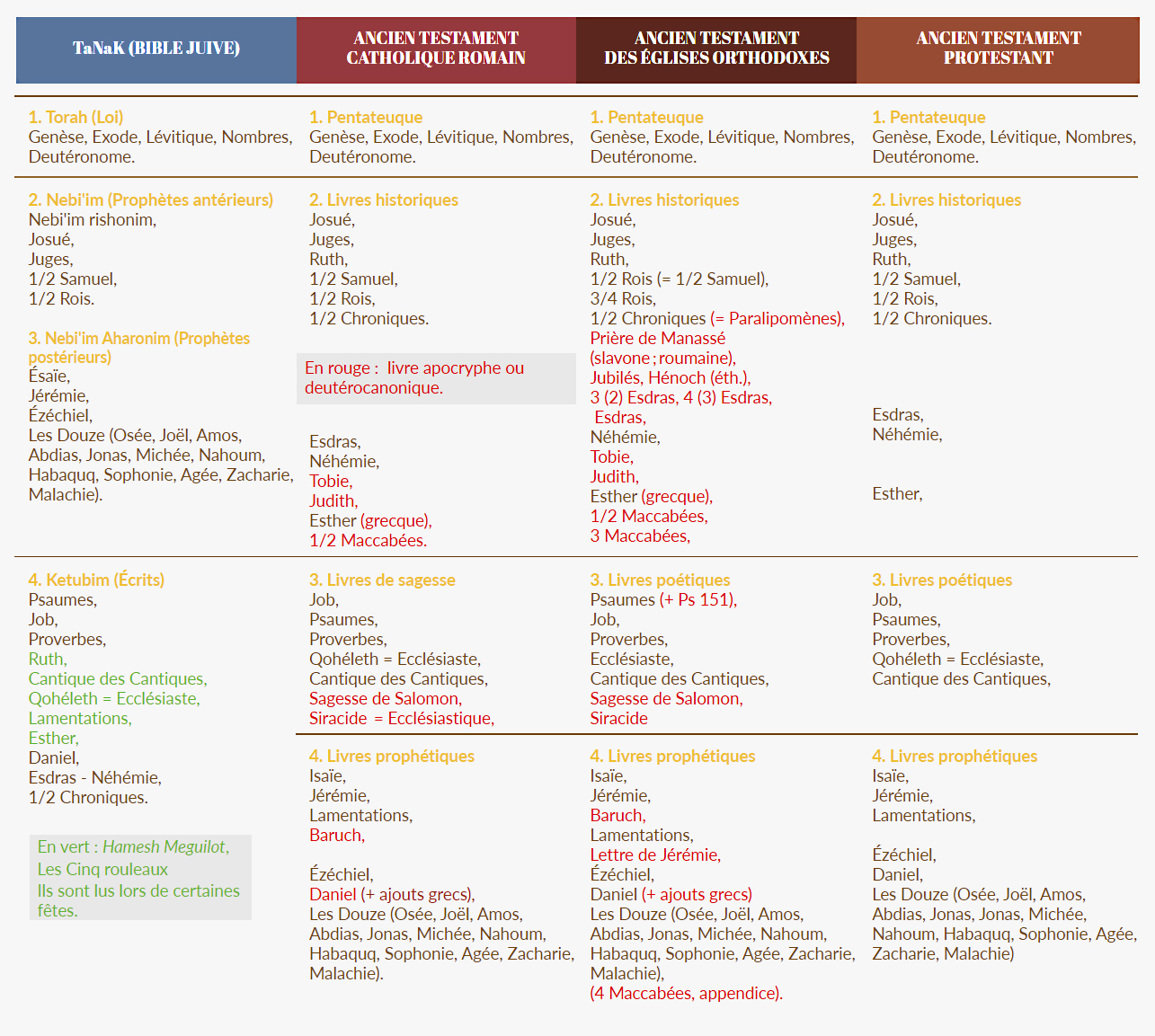
Bible, History, Archaeology
Bible,
History,
Archaeology
The books of
the Old Testament
or First Alliance
In the 4th century BC, the five books of the Torah were definitively established. The Jewish canon was established at the end of the 1st century CE. By taking the first letters of the three names, Torah, Nevi'im, Ketuvim, the Jews formed the word TaNaKh, by which they name the Scriptures.
In the Ketuvim,five books are referred to as the Hamesh Megilot, the Five Rollers« (*). They are read on certain Jewish holidays.
To view the illustrated version, click on the image
In the traditional Jewish order
A set of 24 collections comprising 39 books
Torah
Pentateuch
5 books
Genesis
Exodus
Leviticus
Numbers
Deuteronomy
Nevi'im Reishonim
Earlier prophets
4 collections of 6 books
Josué
Judges
I Samuel
II Samuel
I Kings
II Kings
Nevi'im Aharonim
Later prophets
2 collections of 15 books
Isaiah or Ésaïe
Jérémie
Ezekiel
Hosea
Joël
Amos
Abdias
Jonas
Micah
Nahum
Habaquq
Sophonie
Haggai
Zacharie
Malachie
Ketuvim
Sacred writings
13 books
Psalms
Proverbs
Job
Songs (*)
Ruth (*)
Lamentations (*)
Ecclesiastes (*)
Esther (*)
Daniel
Ezra
Nehemiah
I Chronicles
II Chronicles
In the order of the Protestant Bible
39 pounds: Protestant churches use the books of the Hebrew canon, but in a different classification.
Pentateuch
5 books
Genesis
Exodus
Leviticus
Numbers
Deuteronomy
History
4 collections of 6 books
Josué
Judges
Ruth
I Samuel
II Samuel
I Kings
II Kings
I Chronicles
II Chronicles
Ezra
Nehemiah
Esther
Poetry and Wisdom
5 books
Job
Psalms
Proverbs
Cleric
Songs
Prophets
17 books
Isaiah or Isaïe
Jérémie
Lamentations
Ezekiel
Daniel
Hosea
Joël
Amos
Abdias
Jonas
Micah
Nahum
Habaquq
Sophonie
Haggai
Zacharie
Malachie
In the order of the Catholic and Orthodox Bible
46 pounds: Catholics and Orthodox have preserved the Vulgate books and their layout. We find the apocryphal books of Tobit, Judith, 1 Maccabees, 2 Maccabees, Wisdom, Ecclesiasticus (or Sirach), Baruch and the Greek complements to the books of Daniel and Esther (*) .
Pentateuch
5 books
Genesis
Exodus
Leviticus
Numbers
Deuteronomy
History
16 books
Josué
Judges
Ruth
I Samuel
II Samuel
I Kings
II Kings
I Chronicles
II Chronicles
Ezra
Nehemiah
Tobit (*)
Judith (*)
Esther
I Maccabees (*)
II Maccabees (*)
Poetry and Wisdom
7 books
Job
Psalms
Proverbs
Cleric
Songs
Wisdom (*)
Clergyman (*)
Prophets
18 books
Isaiah or Ésaïe
Jérémie
Lamentations
Ezekiel
Baruch (*)
Daniel
Hosea
Joël
Amos
Abdias
Jonas
Micah
Nahum
Habaquq
Sophonie
Haggai
Zacharie
Malachie
The languages used by the writers of the Old Testament are Hebrew and Aramaic. Biblical Hebrew is used for almost all of the Old Testament.
The Hebrew alphabet comprises 22 consonant letters. Vowels, transcribed by dots and dashes placed above, in the middle of or below consonants, were not used until the 4th century CE, when the aim was to fix reading (work of the Massorets).
Aramaic became established around the 6th century BC. It is written in cursive and the Hebrews adopted its script, except for religious texts.
In the 3rd century BC, they were written in «square» Hebrew (due to the general shape of the characters).
Aramaic is represented in the Old Testament in Jeremiah 10, Daniel 2 and Ezra 4.
The subdivision of the Bible into chapters is rooted in the Jewish practice of synagogue reading.
But the divisions used today are more recent.
In 1203, Étienne Langton, a scholastic at the University of Paris, divided the Bible into chapters. The division into verses came later. The verse is a unit of rhythm and syntax, making the text easier to read.
It was with the advent of printing in the 16th century that this division was established.
Printers Robert Estienne, his son Henri Estienne and Théodore de Bèze were the architects of the new system.
All the books of the Old Testament (First Covenant), of whatever persuasion, related to the Jewish version (TaNaKh).
To view the table of Old Testament books, click on the image


